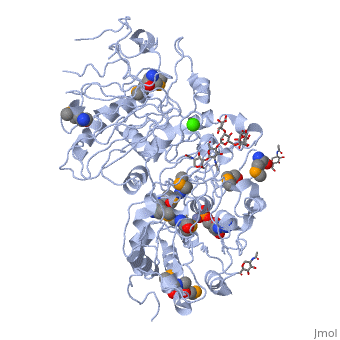4gtw
Crystal structure of mouse Enpp1 in complex with AMPCrystal structure of mouse Enpp1 in complex with AMP
Structural highlights
DiseaseENPP1_MOUSE Defects in Enpp1 are the cause of the tiptoe walking (ttw) phenotype. Ttw mice exhibit ossification of the spinal ligaments.[1] ENPP2_MOUSE Note=May contribute to obesity. FunctionENPP1_MOUSE Appears to modulate insulin sensitivity (By similarity). By generating PPi, plays a role in regulating pyrophosphate levels, and functions in bone mineralization and soft tissue calcification. PPi inhibits mineralization by binding to nascent hydroxyapatite (HA) crystals, thereby preventing further growth of these crystals. Preferentially hydrolyzes ATP, but can also hydrolyze other nucleoside 5' triphosphates such as GTP, CTP, TTP and UTP to their corresponding monophosphates with release of pyrophosphate and diadenosine polyphosphates, and also 3',5'-cAMP to AMP. May also be involved in the regulation of the availability of nucleotide sugars in the endoplasmic reticulum and Golgi, and the regulation of purinergic signaling.[2] [3] ENPP2_MOUSE Hydrolyzes lysophospholipids to produce lysophosphatidic acid (LPA) in extracellular fluids. Major substrate is lysophosphatidylcholine. Also can act on sphingosylphosphphorylcholine producing sphingosine-1-phosphate, a modulator of cell motility. Can hydrolyze, in vitro, bis-pNPP, to some extent pNP-TMP, and barely ATP. Involved in several motility-related processes such as angiogenesis and neurite outgrowth. Acts as an angiogenic factor by stimulating migration of smooth muscle cells and microtubule formation. Stimulates migration of melanoma cells, probably via a pertussis toxin-sensitive G protein. May have a role in induction of parturition. Possible involvement in cell proliferation and adipose tissue development. Tumor cell motility-stimulating factor.[4] [5] [6] Publication Abstract from PubMedEnpp1 is a membrane-bound glycoprotein that regulates bone mineralization by hydrolyzing extracellular nucleotide triphosphates to produce pyrophosphate. Enpp1 dysfunction causes human diseases characterized by ectopic calcification. Enpp1 also inhibits insulin signaling, and an Enpp1 polymorphism is associated with insulin resistance. However, the precise mechanism by which Enpp1 functions in these cellular processes remains elusive. Here, we report the crystal structures of the extracellular region of mouse Enpp1 in complex with four different nucleotide monophosphates, at resolutions of 2.7-3.2 A. The nucleotides are accommodated in a pocket formed by an insertion loop in the catalytic domain, explaining the preference of Enpp1 for an ATP substrate. Structural mapping of disease-associated mutations indicated the functional importance of the interdomain interactions. A structural comparison of Enpp1 with Enpp2, a lysophospholipase D, revealed marked differences in the domain arrangements and active-site architectures. Notably, the Enpp1 mutant lacking the insertion loop lost the nucleotide-hydrolyzing activity but instead gained the lysophospholipid-hydrolyzing activity of Enpp2. Our findings provide structural insights into how the Enpp family proteins evolved to exert their diverse cellular functions. Crystal structure of Enpp1, an extracellular glycoprotein involved in bone mineralization and insulin signaling.,Kato K, Nishimasu H, Okudaira S, Mihara E, Ishitani R, Takagi J, Aoki J, Nureki O Proc Natl Acad Sci U S A. 2012 Oct 16;109(42):16876-81. doi:, 10.1073/pnas.1208017109. Epub 2012 Oct 1. PMID:23027977[7] From MEDLINE®/PubMed®, a database of the U.S. National Library of Medicine. See Also
References
|
| ||||||||||||||||||
